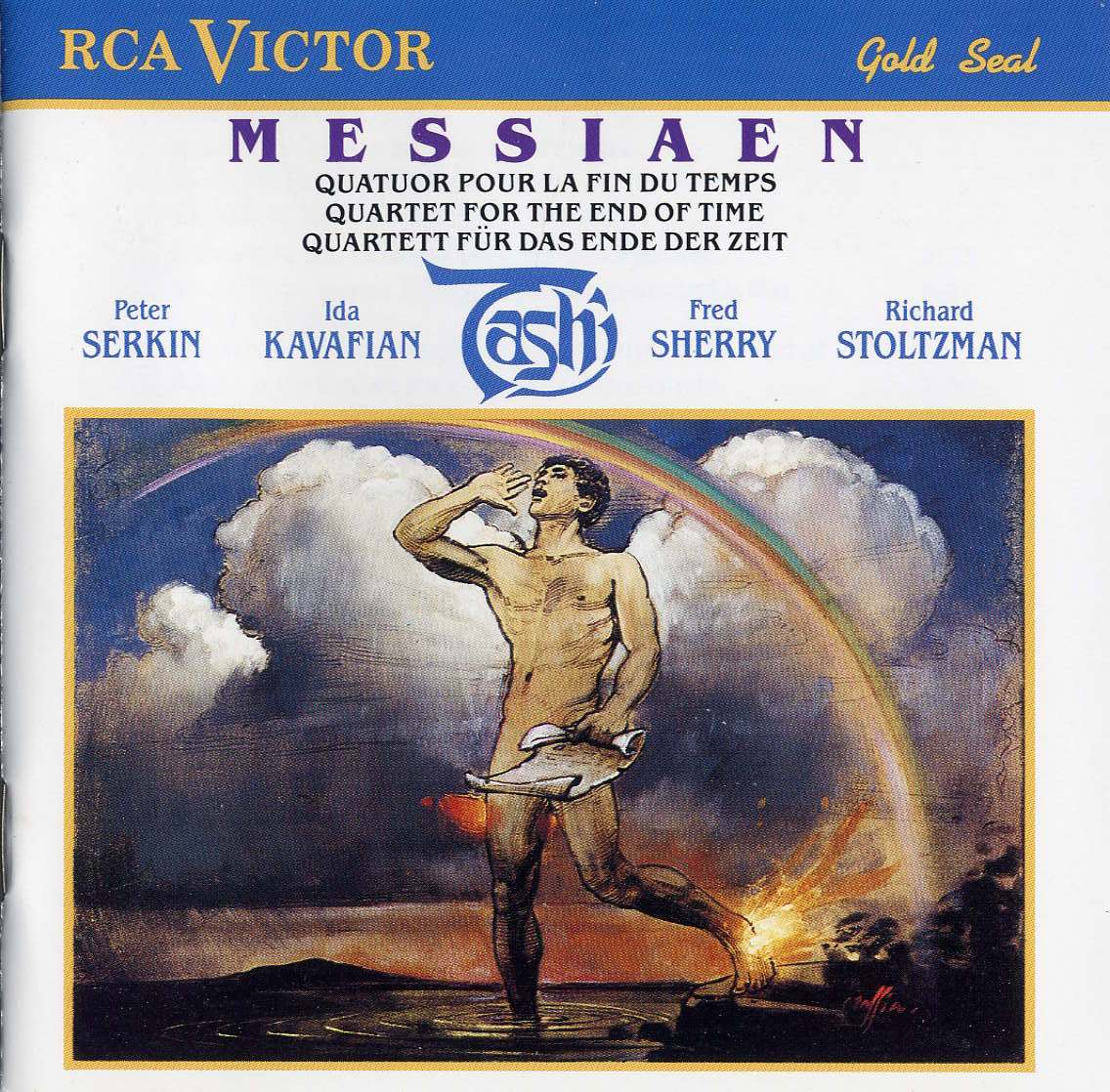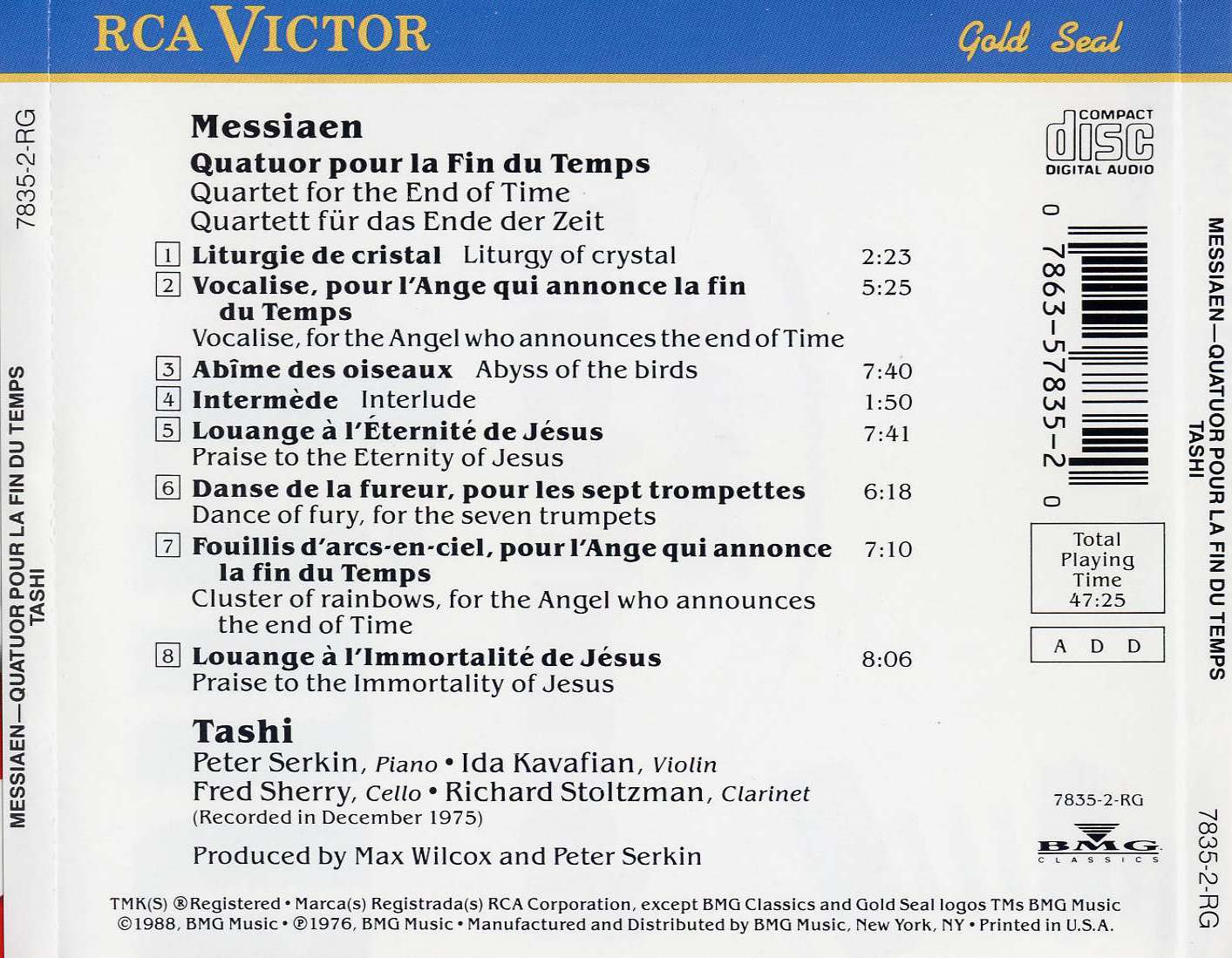

BOOKLET
MESSIAEN Quatuor pour le fin de temps • Tashi • RCA 7835 (47:25)
On rare occasions, a recording appears that introduces to the musical world a performer of such remarkable, distinct character that it immediately establishes that performer’s place in the musical firmament, at the same time itself becoming an iconic performance. Only a few examples come easily to mind: Glenn Gould’s 1955 recording of the Goldberg Variations , or Jacqueline du Pré’s first recording of Elgar’s Cello Concerto, made in 1965 when she was 20 years old.
Other recordings, partially because of time and circumstance, partially as a result of their intrinsic musical power, can define our collective conception of a musical work for a generation or more; or even establish that musical work instantly as a new member of the basic repertoire: in this category we might place Bruno Walter’s live 1936 Vienna Philharmonic performance of Das Lied von der Erde or David Oistrakh’s 1956 premiere recording of Shostakovich’s First Violin Concerto with Dimitri Mitropoulos and the New York Philharmonic.
The recording under consideration here actually fits both of these categories. When it first appeared as an LP listing in Schwann in 1976, having been recorded late the previous year, there were but two other listings for the piece. It is now considered a 20th-century chamber classic, largely because of the influence of this recording, with close to 20 entries on ArkivMusic.com. At the time of the recording, pianist Peter Serkin, clarinetist Richard Stoltzman, violinist Ida Kavafian, and cellist Fred Sherry were all in their twenties; perhaps the greatest loss in the transfer of this LP to CD was the wonderful cover photo of the artists as flower children. This element—the sense of the youthful musicians’ excitement in the discovery of a very new type of musical expression—combines with an obvious sympathy for Messiaen’s unique mix of Catholic mysticism, bird calls, and exotic scalar, harmonic, and rhythmic patterns; and, together with utter instrumental mastery and uncanny accuracy and ensemble, it makes this interpretation a unique document indeed. Of course, Tashi endured for many years, making numerous recordings and commissioning several new works. All four members of the group—which had formed expressly to play this piece—went on to major careers both as soloists and as chamber artists. But their confluence here—Kavafian’s warm, superbly controlled legato combined with her uncanny razor-sharp pitch and rhythm; Stoltzman’s reedy, jazz-influenced sound combined with extraordinary pitch and dynamic control; Sherry’s remarkable sense of ensemble combined with the ability to play flawless harmonics and gorgeous, impossibly long phrases; and, anchoring the entire enterprise, Serkin’s rock-solid rhythmic sense combined with imaginative pedaling—created a dynamic, committed, expressive performance that has never been surpassed. From the joining of four seemingly independent lines in the opening “Liturgie de cristal” to the perfect violin-cello octaves in “Vocalise, pour l’ange qui annonce la fin du temps,” to the stunning range of expression in the solo clarinet’s “Abîme des oiseaux,” to the incredible hair-raising unanimity of “Danse de la fureur, pour les sept trompettes”—on the closing F?, I would swear that Stoltzman and Sherry are actually vibrating in sync—to the impossibly slow, indescribably ethereal “Louange à l’immortalité de Jésus,” this performance is something ineffably unique and special. Forget about the short disc timing; once the last chord has finally died away, there’s simply nothing left to be said.
FANFARE: Richard A. Kaplan
Works on This Recording
1. Quatuor pour la fin du temps by Olivier Messiaen
Performer: Peter Serkin (Piano), Ida Kavafian (Violin), Fred Sherry (Cello),
Richard Stoltzman (Clarinet)
Orchestra/Ensemble: Tashi
Period: 20th Century
Written: 1940; Silesia, Poland
Date of Recording: 12/1975
Length: 47 Minutes 25 Secs.
